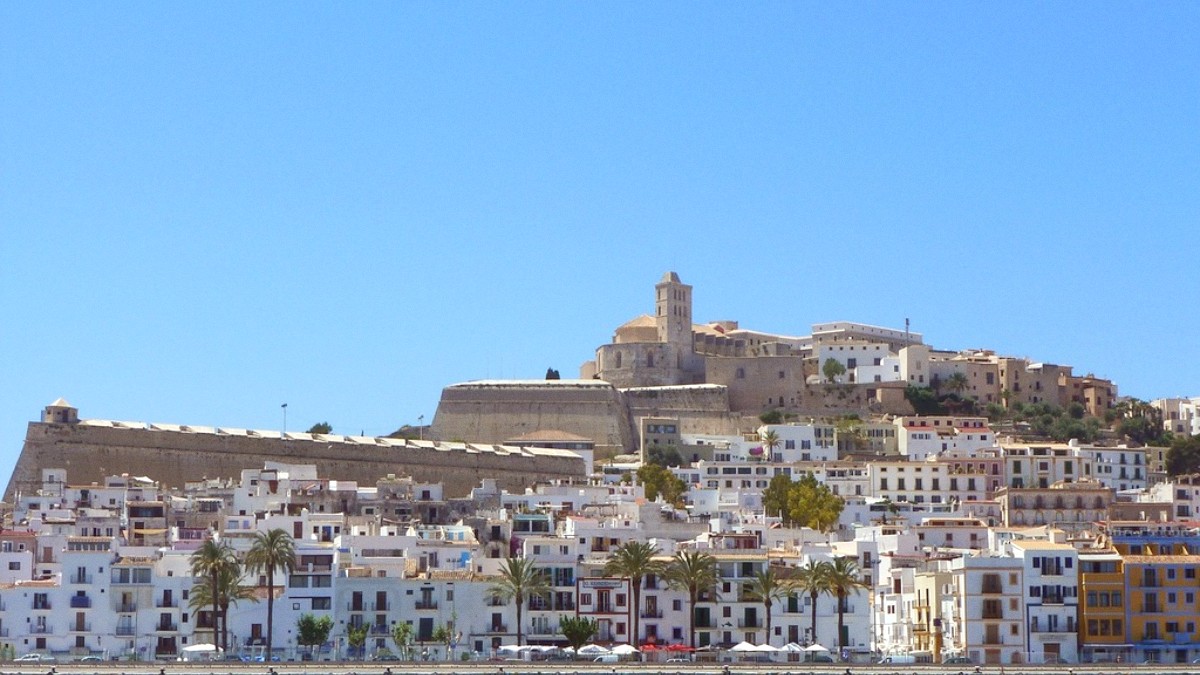
Spain
The island of Ibiza, measuring 572 square kilometers (221 sq mi), holds diverse landscapes, from sandy beaches to rugged interior hills. Ibiza Town itself covers a municipal area of 11.14 square kilometers (4.30 sq mi). This size results in a compact town, much of which is walkable, while still presenting distinct neighborhoods and ample space for its approximately 52,000 residents. The town's layout climbs from the bustling port area up to the fortified heights of Dalt Vila, delivering natural viewpoints and a sense of layered geography. The coordinates, roughly 38.9083° N latitude and 1.4325° E longitude, place it firmly within the Mediterranean climate zone, influencing its weather patterns and natural vegetation. The surrounding sea forms a source of livelihood, a means of connection, and a defining feature of the town's atmosphere. The strategic position in the Mediterranean connected Ibiza Town with diverse cultures, cultivating a rich blend of influences evident even today.
Ibiza Town's natural harbor served as a critical asset throughout its history. Its sheltered waters provided a secure haven for ships, making it a valuable port for trade and defense against maritime threats.
This strategic coastal position facilitated connections with diverse Mediterranean civilizations, allowing the town to flourish as a trading hub and cultivate a rich blend of cultural influences.
Ibiza Town features a deep historical narrative; it is one of Europe's oldest continuously inhabited cities. Phoenician settlers founded the city in 654 BC, establishing it as an important outpost in their vast trading network. They named it Ibossim. This strategic location saw it thrive as a trading hub, connecting various Mediterranean civilizations. Goods from across the sea passed through its port, enriching the settlement and its people.
After the Phoenicians, the Romans arrived, renaming the settlement Ebusus. Roman influence introduced new infrastructure and systems, further integrating Ibiza into the broader Mediterranean world. Later, the Moors conquered the island, calling the town Yabisah. Their presence for several centuries had a lasting impact on the local dialect, architecture, and agricultural practices. The winding streets of Dalt Vila and the traditional irrigation systems on the island still echo this period. Finally, the Catalans re-conquered the island in the 13th century, solidifying its place within the Kingdom of Aragon and later, Spain.
Founding of Ibossim, a trading outpost.
Renamed Ebusus; new infrastructure and integration into the Roman world.
Known as Yabisah; lasting impact on dialect, architecture, and agriculture.
Re-conquest in 13th century; integrated into the Kingdom of Aragon.
Current national affiliation.
The most powerful symbol of Ibiza Town's historical importance is Dalt Vila, the fortified old town. In 1999, UNESCO recognized Dalt Vila as a World Heritage Site. This designation points to its exceptional preservation of Renaissance fortifications. These impressive walls, built in the 16th century by King Charles V, offered protection against pirate raids, a constant threat in the Mediterranean during that era. The fortifications display a mastery of military engineering from the Renaissance period.
Today, visitors walk along the bastions, admiring the craftsmanship and the panoramic views available. Dalt Vila is more than just a collection of old buildings; it functions as a living museum. Its narrow, cobblestone streets wind past ancient churches, traditional houses, and hidden courtyards. Every corner recounts stories of the many peoples who shaped this town.
The town's enduring role as a coastal fortress and a nexus for trade illustrates its enduring historical relevance in the Mediterranean. This long and varied history means that walking through Ibiza Town resembles stepping through time, with each layer of civilization leaving its mark.
Dalt Vila's well-preserved fortifications offer stunning views over the town and sea, a testament to its strategic past.
The official name of the town is Eivissa in Catalan, the local language, while English speakers commonly refer to it as Ibiza Town. This dual naming reflects the island's unique cultural identity and its appeal to an international audience. The town sits on the southeast coast of Ibiza, functioning as the island's administrative and cultural heart.
As of 2023 estimates, the municipality is a population of approximately 52,000 people. This population increases considerably during the peak summer months with the influx of tourists, altering the town's energy and services.
Catalan (official), Spanish (Castilian). English appears widely understood in tourist areas. Learning basic Spanish/Catalan phrases gains appreciation.
Euro (€). ATMs are readily available, and credit/debit cards are widely accepted.
Central European Time (CET, UTC+1). Central European Summer Time (CEST, UTC+2) during summer months.
Tourism is the main industry in Ibiza Town, propelling much of its economy and influencing its seasonal rhythms.
The UNESCO World Heritage Site, acting as the crowning jewel with ancient walls and winding streets for historical exploration.
A lively hub where luxury yachts moor alongside traditional fishing boats, and ferries link the island to the mainland and neighboring Formentera.
An ancient burial ground that delivers a fascinating glimpse into the island's Phoenician and Roman past, complete with an archaeological museum.
Eivissa (Catalan), Ibiza Town (English)
Approximately 52,000 (increases significantly in summer)
Dalt Vila (UNESCO), Port, Necropolis, Vara de Rey